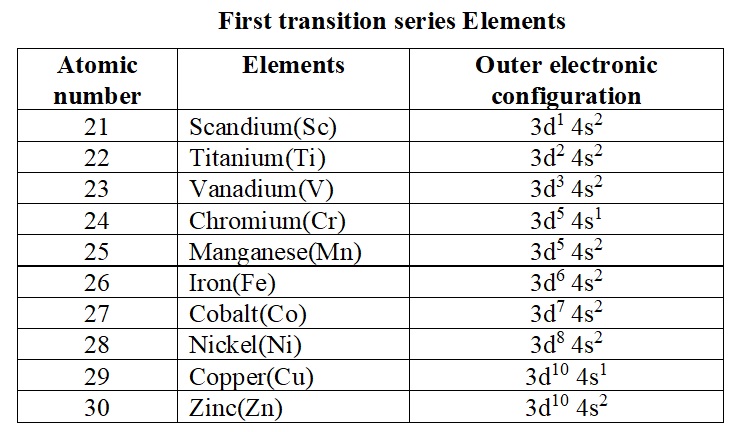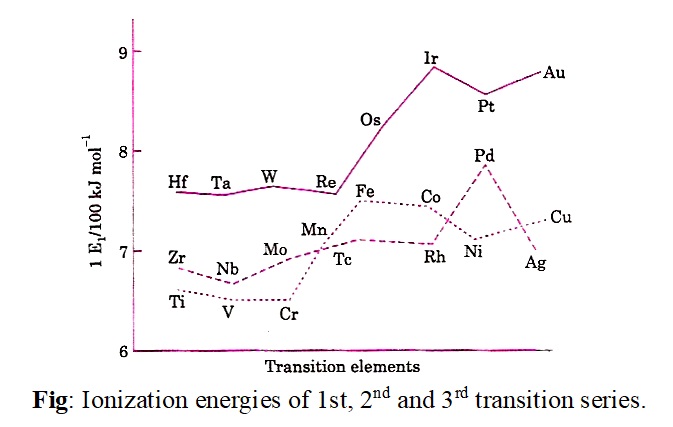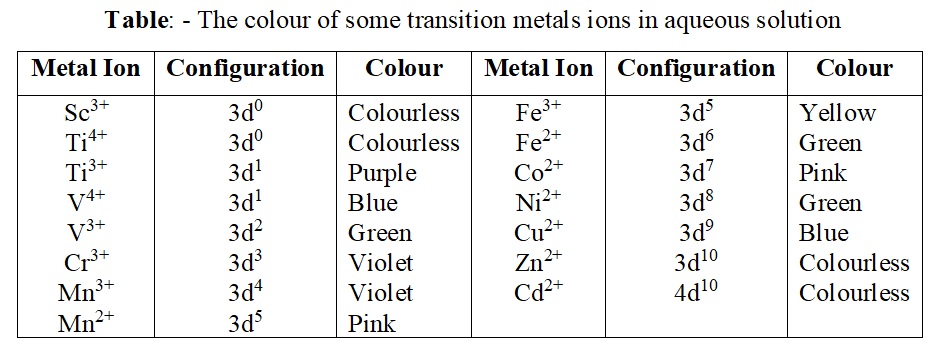d – Block elements: On the basis of electronic configurations, the elements have been broadly classified into four blocks namely s, p, d and f blocks respectively. The d-block elements are called transition elements. This block consists of element lying between s and p blocks, starting from fourth period and onwards. In this element, the outer most shell contains one or two electrons in their s-orbital (ns) but the last electron enters the last but one d-subshell i.e. (n-1)d. The elements of this block have general characteristic properties intermediate between the elements of s and p block. In other wards, d-blocks elements represent change or transition in properties from most electropositive s-block elements to least electropositive p-block elements. Therefore, these are called transition elements. Thus,
“The transition elements may be defined as those elements which have partially filled d-sub shell in their elementary form or in their commonly occurring oxidation state”. This defination covers metals like Cu, Ag and Au as transition metals because in their commonly occurring oxidation states, they have partially filled d-subshell. e.g. Cu+2 has 3d9 configuration, Ag+ has 4d9 configuration, Au+3 has 5d8 configuration, although all these three atoms have completely filled d-sub shell in their elementary state (Cu:3d10, Ag:4d10, Au:5d10). However, the above definitions do not include Zn, Cd and Hg. These elements do not have partly filled d-subshell in their elementary state. However, these may be treated along with transition elements because they are quite similar to the other transition elements in some of the chemical properties.
Electronic configurations: In the transition elements, the d-orbital are successively filled. The general electronic configuration for the atoms of d-block is – (n-1) d1-10ns1-2
Transition series:
The transition element consists of three complete rows of ten elements and one incomplete row. These rows are called first, second and third transition series which involve the filling of 3d, 4d and 5d-orbitals respectively. The first transition series involve the filling of 3d-orbitals. It starts from scandium (Z=21) and goes up to zinc (Z=30).
The second transition series involves the filling of 4d-orbitals and include ten elements from yttrium (Z=39) to cadmium (Z=48). The third transition series involves the filling of 5d-orbitals. The first elements of this series is lanthanum (Z=57). It is followed by fourteen elements called lanthanide which involves the filling of 4f-orbitals. The next nine elements from hafnium (Z=72) to mercury (Z=80) belongs to third transition series.
The fourth transition series starts from actinium (Z=89) and is incomplete. It will include elements from atomic number 104 onwards.
First transition series:
The first transition series consists of elements from scandium (Sc=21) to zinc (Zn=30). In scandium, the 3d-orbitals starts filling up and its electronic configuration is [Ar] 4s2 3d1. As we move from Sc onwards 3d-orbitals get filled up more and more till the last element, Zn in which the 3d-orbitals are completely filled i.e. [Ar] 4s2 3d10.
It may be noted that the configuration of Cr and Cu are anomalous. We know that half-filled and completely filled electronic configuration i.e. d5 and d10, have extra stability associated with them. Thus, to acquire increased stability, one of the 4s-electron goes to nearby 3d-orbitals so that 3d-orbitals becomes half-filled in case of Cr and completely filled in case of Cu. Therefore, the electronic configuration of Cr is [Ar] 3d5 4s1 rather than [Ar] 3d4 4s2 and that of Cu [Ar] 3d104s1 instead of [Ar] 3d9 4s2.

General trends in the chemistry of first row transition elements: Transition elements show some interesting properties. Some of the important properties of transition metals are discussed below:
i) Metallic character:
All transition elements are metallic in nature and nearly all of them have simple hcp, ccp or bcc lattices which are characteristics of other metals. The metallic characters of transition elements are due to their low ionization energy and number of vacant orbital in the outermost shell. Due to the presence of strong metallic bonds, the transition metals are hard; possess high densities and high enthalpies of atomization. The hardness of metals suggests that the presence of strong bonding due to overlap of unpaired electrons between different metal atoms. Greater the number of unpaired electrons, more numbers of bonds and therefore greater is the strength of these bonds. e.g. Cr, Mo, and W have maximum number of unpaired electrons and therefore, these are very hard metals. On the other hand, Zn, Cd, and Hg do not have any unpaired electrons; therefore, these are not very hard.
ii) Ionization energy:
The first ionization energies of d-block elements are higher than those of s-block elements but lower than p-block elements. In a particular transition series, ionization energy increases gradually as we move from left to right. However, the relative difference of IE1 values of any two consecutive d-block elements of particular period is much smaller than those of s-and p-block elements. The increase in ionization energy is primarily due to increase in nuclear charge. As the transition elements involve the gradual filling of (n-1)d-orbitals, the effect of increase in nuclear charge is partly cancelled by the increase in screening effect. Consequently, the increase in ionization energy along the period of d-block element is very small.
The ionization energies of 3d, 4d and 5d-transition series are shown below graphically. It may be noted that 5d-transition elements possess higher ionization energy than 3d- and 4d-transition elements. This is because of the greater effective nuclear charge in these elements due to the ineffective shielding of the nucleus by 4f-electrons.

Note: The values of ionization energies give information regarding the stability of the transition metal compounds in different oxidation states. E.g. the first ionization energy of Ni and Pt are-

It is clear from the above figure that the sum of first two ionization energy is less for nickel than for platinum.
Ni ——-> Ni+2 + 2e IE = 2.49 x 103 kJ/mol
Pt ——-> Pt+2 + 2e IE = 2.66 x 103 kJ/mol
Therefore, ionization of Ni to Ni+2 is energetically favorable as compared to that of platinum. Thus, nickel (II) compounds are thermodynamically more stable than platinum (II) compounds. On the other hand, the sum of first four ionization energies is less for Pt than for Ni as-
Ni ———> Ni+4 + 4e IE = 11.29 x 103 kJ/mol
Pt ——–> Pt+4 + 4e IE = 9.36 x 103 kJ/mol
Thus, the Pt (IV) compounds are relatively more stable than Ni (IV) compounds. Therefore, K2PtCl6 is well known compound whereas the corresponding nickel compound is not known
Electrode potentials:
In addition to ionization energy, the other factors such as enthalpy of sublimation, hydration energy etc. determines the stability of a particular oxidation state in solution. It can be explained in terms of their electrode potential values. The oxidation potential of a metal involves the following process:
M (s) ——> M+ (aq) + e–
Oxidation state:
All transition metals exhibit a great variety of oxidation states. The oxidation states of transition elements are listed in Table below. The less common and unstable oxidation states are given in the parentheses. The stability of a particular oxidation state depends upon the nature of the element with which the transition metal forms the compound. The highest oxidation states are found in compounds of fluorine and oxygen. This is due to the high electronegativity values and small size of fluorine and oxygen.
The variable oxidation states of transition elements are due to the participation of ns and (n -1)d electrons in bonding. The lower oxidation state is generally exhibited when ns-electrons participate in bonding and higher oxidation states is shown when ns as well as (n -1) d-electrons take part in bonding. It may be noted the oxidation states of transition elements differ from each other by unity whereas oxidation states of non-transition elements generally differ by two.

Some important features of oxidation states of the transition elements are as follows:
- In each group, the highest oxidation state increases with increase in atomic number, reaches a maximum in the middle and then starts decreasing. For example, for the first transition series the maximum oxidation state is shown by manganese.
- The elements which exhibit the maximum number of oxidation states occur either in or near the middle of the series. For example, in the first transition series manganese exhibits maximum number of oxidation states (+2 to + 7).
- The elements in the beginning of the series exhibit fewer oxidation states because they have small number of electrons which they can lose or contribute for sharing. The elements at the end of the series exhibit fewer oxidation states because they have too many d-electrons and hence have fewer vacant d-orbitals which can be involved in bonding.
- For the elements of first transition series (except scandium) +2 oxidation state is the most common oxidation state. This oxidation state arises due to the loss of 4s-electrons.
- The transition elements in lower oxidation states (+ 2 and + 3) generally form ionic bonds. In higher oxidation states, the bonds formed are essentially covalent. For example, in chromate ion (Cr04-2), the bonds formed between chromium and oxygen are covalent.
- The highest oxidation state shown by any transition metal is +8. For example, ruthenium and osmium show highest oxidation states of + 8 in some of their compounds.
- Some transition metals also show oxidation state of zero in their compounds. [Ni(CO)4] and [Fe(CO)5] are common examples.

Atomic and Ionic radii:
The atomic and ionic radii of transition elements are smaller than those of s-block elements and larger than those of p -block elements. Among the elements of the particular transition series, as the atomic number increases, the atomic radii first decrease till the middle, become almost constant and then increases towards the end of the period. For example, the atomic radii of first transition series decreases from Sc to Cr, remains almost constant till Cu and then increases towards the end.
Explanation: The decrease in size in the beginning is attributed to the increase in nuclear charge. However, the increased nuclear charge is partly cancelled by the increased screening effect of electrons in the d-orbitals of penultimate shell. When the increased nuclear charge and increased screening effect balance each other, the atomic radii become almost constant. Increase in atomic radii towards the end may be attributed to the electron- electron repulsions. In fact, the pairing of electrons in d-orbitals occurs after d5– configuration. The repulsive interactions between the paired electrons in d-orbitals become very dominent towards the end of the period and cause the expansion of electron cloud and thus, resulting in increased atomic size. The ionic radii also follow the similar trend.

The elements of second and third transition series belonging to a particular group have almost equal atomic radii. This is because of lanthanide contraction. For example, atomic radii of zirconium and hafnium are 160 pm and 159 pm respectively.

Magnetic Properties:
The substances, which contain some species (atoms, ions or molecules) with unpaired electrons in their orbitals, behave as paramagnetic substances. Such substances are weakly attracted by magnetic field. On the other hand, the substances whose constituent particles do not contain any unpaired electrons are repelled by magnetic field and are called diamagnetic.
The transition metal ions generally contain one or more unpaired electrons in them and hence their complexes are generally paramagnetic. The paramagnetic character increases with increase in number of unpaired electrons. The paramagnetism is expressed in terms of magnetic moment. Larger the value of magnetic moment, greater is the paramagnetic character. The magnetic moments arise only from the spin of the electrons and can be calculated using the relation.
μ=√n (n+2, Where n is the number of unpaired electrons
The value magnetic moments of some ionic species belonging to first transition series are given below:

Catalytic Properties:
Many transition metals and their compounds are known to act as catalysts. For example, finely divided iron acts as catalyst in the manufacture of ammonia by Haber process, vanadium pentoxide (V2O5) or platinum act as catalyst for the oxidation of SO2 to SO3 in Contact Process, ferrous sulphate and hydrogen peroxide (Fenton’s reagent) are used for the oxidation of alcohols to aldehydes.
Complex Formation:
Transition metals, in general, have a tendency to form a large number of complex compounds. Complex compounds are those which have a metal ion (or an atom as in nickel tetra carbonyl) linked to large number of ions (generally negative) or neutral molecules having one or more lone pairs of electrons. These ions or molecules are known as ligands. They donate one or more lone pairs of electrons to the central transition metal ion (or atom) forming co-ordinate bonds. These complex compounds exhibit characteristic properties. Some common examples of complex compounds are:
[Cu(NH3)4]2+, [Ag(NH3)2]+, [Ni(CO)4], [Fe(CO)6]3-, [Fe(CO)6]4-, [PtCl4]2-, etc.
Such complex compounds are generally not formed by representative (s and p-block) elements. The relative stabilities of different complex compounds of transition elements are as follow:
- Within a transition series, the stability of complexes, in general, increases with the atomic number.
- In case of transition metals which show more than one oxidation state, the complex in which the transition metals show a higher oxidation state is more stable. For example, Fe3+ complexes are more stable than Fe2+
Explanation: The tendency of transition elements to form complexes is due to the following reasons.
- They have small atomic or ionic size.
- They have large effective nuclear charge.
- They have vacant d-orbitals of suitable energy to accept lone pairs of electrons donated by the ligands.
Coloured Ions:
The compounds of transition elements are usually coloured both in solid state and in aqueous solution. The colour of these complexes is due to the presence of unpaired electrons in it. This can be explained as–
The d-orbitals in the transition elements do not have same energy in their complexes. Under the influence of the ligands attached, the d-orbitals split into two sets of orbitals having slightly different energies. In the transition elements which have partly filled d- orbitals, the transition of electron can take place from one of the lower d-orbitals to some higher d-orbital within the same sub-shell. The energy required for this transition falls in the visible region. So when white light falls on these complexes they absorb a particular colour from the radiation for the promotion of electron and the remaining colours are emitted. The colour of the complex is due to this emitted radiation. For example, cupric salts are bluish green due to absorption of red light. Ti3+ salts appear purple due to absorption of yellow light.
Zn2+ and Ti4+ salts are white because they do not absorb any radiation in the visible region. In these compounds, d-d transitions are not possible because in Zn2+ all the d-orbitals are fully- filled whereas in Ti4+all the d-orbitals are vacant. The colours of some transition metal ions in aqueous solutions are given below.

Interstitial Compounds:
Compounds in which small atoms like C, H, N, etc are entrapped in the crystal lattice of metals are called interstitial compounds. e.g. TiC, Mn4N, Fe3H, TiH2, etc. The products so obtained are hard and rigid. For example, steel and cast iron become hard due to the formation of interstitial compound with carbon. In these compounds, properties such as malleability and ductility are lost to a smaller or greater extent but their tenacity increases. As no true chemical bond is formed between the atoms of transition metal and the small atoms present in interstices these interstitial compounds are non-stoichiometric in nature i.e., the ratio between the atoms of transition metal and the atoms present in interstices is not fixed.
Alloy Formation:
Transition metals form a number of alloys. Such alloys are hard, have high melting points, and are more resistant to corrosion than the pure metal. In these alloys, properties such as malleability and ductility are lost to smaller or greater extent. Some common examples of alloys of transition metals are; Brass (copper and zinc); Stainless steel (iron, chromium and nickle); Tungsten steel (iron and tungsten) ; Molybdenum steel (iron with molybdenum) ; Chrome steel (iron with chromium) etc.
Explanation: The tendency of transition metals to form smooth and excellent alloys can be explained on the basis of their atomic sizes. The atomic sizes of transition metals are very similar and hence in the solution of crystal lattice, atoms of one metal can be readily replaced with atoms of another transition metal. This results in the formation of solid solutions and smooth alloys.